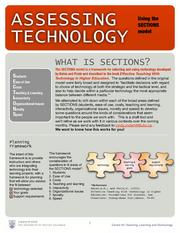Documentation:Learning Technologies in Teaching and Learning
Session Objectives
- Participants will develop an understanding of the broad goals for using learning technologies in teaching and learning
- Participants will develop an understanding of the SECTIONS framwork and reflect on its application in their teaching context
- Participants will identify examples of learning technologies used in the classroom for presentation, collaboration and sharing
- Participants will be able to find and navigate online learning technology resources in the e-Learning Toolkit
- Participants will consider aspects of their own teaching practice that they are in the process of developing and consider how different learning technologies might assist them in their process
Session Agenda
- Activity: Your teaching and learning goals/challenges
- Presentation: Overview of learning technologies
- Activity: Exploring the UBC eLearning Toolkit
- Activity: Using the SECTIONS model
- Demonstration: Tools for presentation, sharing and collaboration
- Play time: An opportunity to login to some tools and try them out
What is a learning technology?
- The term learning technologies encompasses information and instructional technology, as well as telecommunications tools, applications, and systems that support learning.
EDUCAUSE Learning Initiative
Select teaching and learning goals
- Provide scaffolds and tools to enhance learning
- Give students and teachers more opportunities for feedback, reflection and revision
- Engender the development of local and global communities
United States National Research Council, 2008
Possible goals for e-learning
- To increase access to learning opportunities/increase flexibility for students
- To enhance the general quality of teaching/learning.
- To develop the skills and competencies needed in the 21st century, and in particular to ensure that learners have the digital literacy skills required in their discipline, profession or career – or, put simply, to get work in the future
- To meet the learning styles/needs of millenial students
- To improve the cost-effectiveness of the post-secondary education system
- To stay at the leading edge of educational technology developments/to digitalise all learning – or put another way, to respond to the technological imperative
- To de-institutionalise learning/to enable self-managed learning.
- To embark on a journey of mystery to see where it will take me.
Tony Bates, 2009
The eLearning Toolkit UBC
UBC's e-Learning Toolkit is for those new to using technology in education or those looking for new ideas and best practices. In the Toolkit, you will find a definition of each learning tool, sample uses, some benefits, tips on how to get started, and additional resources.
Activity: Exploring the eLearning Toolkit
Work individually and identify 3 tools that would be valuable in the context of your teaching and learning. For each of the tools identify:
- Examples
- Resources
- Tips
- Value in the context of your teaching and learning
The SECTIONS Framework
- The SECTIONS model provides a framework for the selection of learning technologies.
- The SECTIONS framework was developed by Bates and Poole in the book 'Effective Teaching with Technology in Higher Education'
- This framewok has been adapted to the context of UBC and combined with a design process Define, Implement, Assess, Refine
Activity: Using the SECTIONS Framework
- Identify one learning objective or goal and activity that you would like to implement in your teaching
- Select possible learning technologies. Complete the 1st section of the SECTIONS framework
Demonstration: Learning Technologies
- Collaborate and share
- WordPress MU: Web-based blogging and content management system
- Media Wiki: Collaborative Webspace
- Present and Create
- Google Google Documents: Online presentation tool
- Prezi: Online presentation tool
Examples
- WordPress MU
- AMST 303: Consumerism UMW
- (http://blogs.ubc.ca/communicatingscience2010W200/ Scie 200: Communicating Science]
Activity: Exploring Learning Technologies
Using the provided login play with some of the platforms that we have gone over today and consider them in the context of your teaching and learning.
